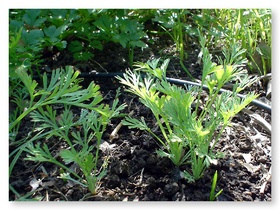California Golden Poppy (Eschscholzia californica) is our beloved state flower, most beautiful of all state flowers. On December 12, 1890, the California State Floral Society voted to select a state flower — the nominees were the California poppy (Eschscholzia californica), the Matilija poppy (Romneya coulteri) and the mariposa lily (Calochortus sp). The California poppy won by a landslide. Sometimes known as the flame flower, la amapola, and copa de oro (cup of gold), the poppy grows wild throughout California and is celebrated annually on April 6. In 1902 a song, "Golden Poppies Good Night," was published in San Francisco celebrating the state flower.
The California poppy had been first described 70 years before, and it already had 64 years of horticultural history. California Native Americans cherished the poppy as both a source of food and oil extracts. Although the California poppy had surely already been seen by Europeans, possibly as early as 1542, it was first described by Adelbert von Chamisso (1820) based on a collection from San Francisco in 1816. Chamisso named the genus in honor of Johann Friedrich Eschscholtz, his close friend. The greatest taxonomic impact on the genus came from Edwin Lee Greene, first botanist at the University of California and a taxonomic "splitter"; it was rumored that he could collect material from a plant, name it a new species, return to the site later in the same season, unknowingly collect from the same plant, and name it a different species. Greene named a total of 116 new species, subspecies, and varieties in Eschscholzia — just eight of Greene's species are still recognized.
 Seedling identification of California Goldens is a snap! Eschscholzia californica is an upright, compact annual or tender perennial native to California and the southwestern United States. It is sun-loving, extremely drought tolerant, frost tolerant and well-suited to our Davis climate. The brilliant orange, cup-shaped flowers, are 2-4 inches in diameter and are borne individually on long stalks; blooms close at sunset and overcast days. The foliage is a softly distinctive blue-green color making early plant identification very easy. Poppies do not transplant well but self-seed freely, so if you've ever planted poppies in your yard, expect to see their arrival each spring and lasting throughout summer. Note that poppy seeds often sold in stores are cultivars that can weaken native species
Seedling identification of California Goldens is a snap! Eschscholzia californica is an upright, compact annual or tender perennial native to California and the southwestern United States. It is sun-loving, extremely drought tolerant, frost tolerant and well-suited to our Davis climate. The brilliant orange, cup-shaped flowers, are 2-4 inches in diameter and are borne individually on long stalks; blooms close at sunset and overcast days. The foliage is a softly distinctive blue-green color making early plant identification very easy. Poppies do not transplant well but self-seed freely, so if you've ever planted poppies in your yard, expect to see their arrival each spring and lasting throughout summer. Note that poppy seeds often sold in stores are cultivars that can weaken native species
these should only be planted in urban areas where native plants are not likely to survive.
 Curtis Clark, a UC Davis graduate student in 1975, has written a thoroughly informative site from which much of this information was culled.
Curtis Clark, a UC Davis graduate student in 1975, has written a thoroughly informative site from which much of this information was culled.
Did you know that California has many other native poppy species besides the California Golden Poppy? To learn more about other poppies, native plants, or plants growing within Davis, please visit our pages about Poppies, Native Plants, or Town Flora.




